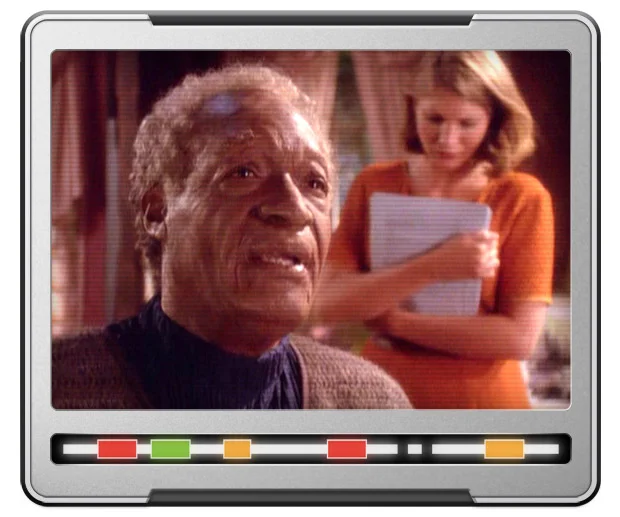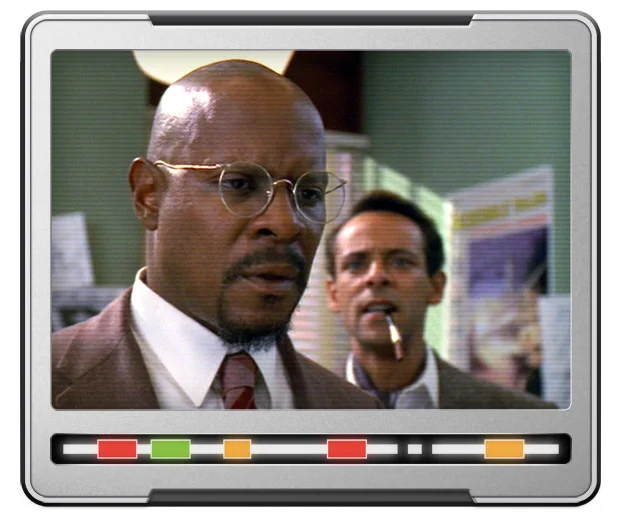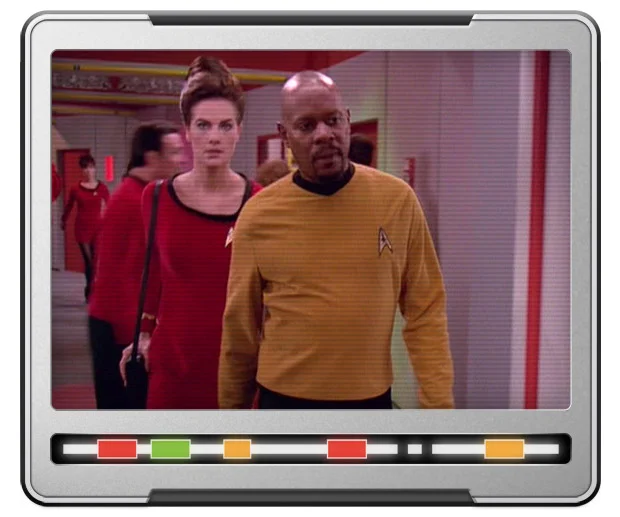An audio version of this Captain’s Log is available.
by Christopher Jones
Asking a fan to name the five best episodes of a Star Trek series is like asking Quark which Rules of Acquisition are the best. There are too many that lead to profit to choose just five. Neverthless, I’m going to set out to name five of the best episodes from DS9.
The Visitor
The only episode of Deep Space Nine to be nominated for the Hugo Award, “The Visitor,” is a story that works with or without the Star Trek elements, and that makes it pure science fiction at its best. This account of Jake Sisko’s life following the apparent death of his father tugs on the heartstrings and effectively conveys to the viewer that enormous sense of loss, anguish, and guilt. Feeling responsible for the accident that caused Captain Sisko to lose his life, Jake spends years looking for a way to bring him back. He studies science at the cost of his writing career, his marriage, and his health. In the end he comes to find that only his own death can restore things to the way they were, and he sacrifices himself to save the person he loves most.
Far Beyond the Stars
In 1998, during Black History Month, DS9 aired one of the most creative stories in Star Trek history. Under the stress of the Dominion War, Sisko loses consciousness and finds himself in 1953 New York working as an SF writer named Benny Russell. “Far Beyond the Stars” is the tale of Russell’s struggle as a black writer in the 1950s who must conceal his identity and who fights to publish his story about a future space station and its black commander. More than just another commentary on racism, “Far Beyond the Stars” explores the feeling of insiginificance humanity faces as we learn how vast the universe really is, and delivers one of DS9’s most memorable quotes when the Preacher tells Benny “You are the dreamer—and the dream.” Without a doubt one of Star Trek’s finest moments.
Past Tense
Halfway through DS9’s third season came this two-part episode that was a glimpse of the greatness to come. Like “The City On the Edge of Forever” 28 years earlier, “Past Tense” tackles the issue of homelessness and poverty. But unlike TOS’s foray, “Past Tense” delves into the societal and governmental reaction to the problem, revealing the cold shoulder that most of the “haves” of the world turn on the “have-nots,” and the possible long-term consequences. The story is set in the year 2024—Sisko, Bashir, and Dax having been thrown back in time by a transporter malfunction—and thus says something about the urgency of the problem as it faces American society. Thrown into special “districts” of San Francisco—essentially walled prisons—people whose only crime is not having a job finally reach the breaking point and revolt. Caught in the middle, it is up to Sisko to protect the timeline when a historical figure is killed prematurely. Forgetting all the nonsense about the transporters and the timeline, no viewer can fail to stop, if only for a moment, and think about this injustice of our society. Effective storytelling.
Sacrifice of Angels
What appeared to be the culmination of the Federation-Dominion War proved to simply be one of several turning points in the conflict. Nevertheless, “Sacrifice of Angels” is about as exciting as they come and features special effects of a quality rarely seen on television (in those days). But beyond these fun superficial elements is a story a love, betrayal, and loss. As the long-lived tension between Gul Dukat and his daughter reaches its apex, it appears that a happy resolution is at hand when she admits that she loves him. At that moment we are granted a glimpse into the heart of an evil man, and see a tiny, flickering flame of goodness. But when it becomes clear that the title refers not to the destruction of the Prophets and the wormhole, but to the death of Ziyal at the hands of Dukat’s assistant, Damar, the house of cards comes tumbling down. In the end, one of the most powerful scenes in the Star Trek canon comes when a broken, dejected Dukat morosely returns Sisko’s baseball, saying only “I forgive you.”
Trials and Tribble-ations
In honor of the 30th anniversary of Star Trek, both DS9 and Voyager produced special episodes. And while Voyager’s “Flashback” was great, it was “Trials and Tribble-ations” that had its cake and ate it, too. Marrying the best of the past with the best of the present, DS9 used techniques perfected in Forrest Gump to send Sisko and crew back to Deep Space Station K-7 where they witness firsthand the events of the classic TOS episode “The Trouble With Tribbles.” The original Enterprise never looked so beautiful, and comic moments abound. One of the many highlights is when Worf is questioned about the difference in appearance between current Klingons and those of TOS. His response? “We do not discuss it with outsiders.” If you’ve never seen this one, do yourself a favor and watch it tonight. A fabulous tribute.
Other Favorites
In addition to these five, here are some other episodes that I consider the best of Deep Space Nine:
“A Time to Stand”
“Babel”
“Badda Bing-Badda Bang”
“Call to Arms”
“Crossover”
“Defiant”
“Doctor Bashir, I Presume?”
“Homefront”
“If Wishes Were Horses”
“In the Pale Moonlight”
“Little Green Men”
“Paradise Lost”
“Playing God”
“Rapture”
“Rejoined”
“Shattered Mirror”
“Tears of the Prophets”
“Through the Looking Glass”
“Visionary”
“What You Leave Behind”
“Whispers”
So those are my picks for the best of DS9. Certainly there are many others that I love and that are great examples of Star Trek. Think of this as a starting point. No doubt you’ll disagree with some of my picks, and you may even think I’m a Cardassian vole for leaving your favorite off the list. But that passion and debate is what has allowed Star Trek to endure for 45 years. So feel free to add to the comments below and let me know which episodes are your favorites and why you love them.






